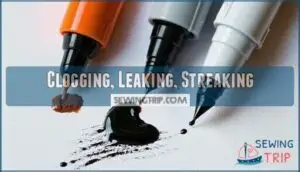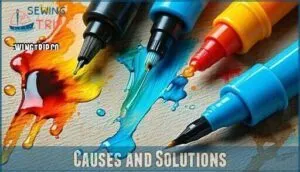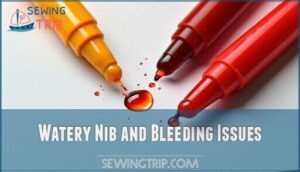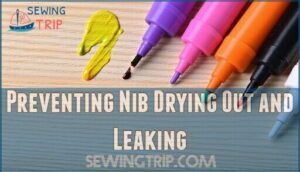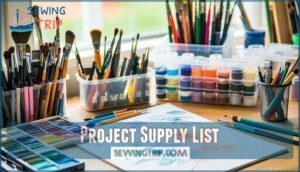This site is supported by our readers. We may earn a commission, at no cost to you, if you purchase through links.
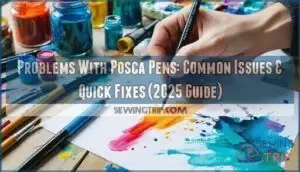
The most frequent issues include clogged tips that won’t flow properly, inconsistent ink coverage that creates streaky lines, and nibs that dry out faster than expected.
You might also encounter bleeding through paper, paint that chips off certain surfaces, and leaking that stains your workspace.
These markers can be temperamental about surface compatibility, and their limited color range sometimes forces you to get creative with mixing.
The good news is that most of these headaches stem from simple maintenance mistakes or technique issues that have straightforward fixes.
Table Of Contents
Key Takeaways
- You’ll encounter three main problems with Posca pens: clogged tips that won’t flow properly, inconsistent ink coverage creating streaky lines, and nibs that dry out faster than expected—but most stem from simple maintenance mistakes you can easily fix.
- Proper storage and activation prevent most issues: Store your pens horizontally with caps tightly secured, shake them vigorously before use, and soak clogged nibs in warm water for several minutes to restore smooth ink flow.
- Surface preparation matters more than you’d think: Test compatibility on hidden areas first, clean surfaces thoroughly before applying, and consider using primer on challenging materials to prevent paint from wearing off or bleeding through.
- You can revive seemingly dead pens: Don’t toss dried-out Posca pens—submerge only the tip in warm water for several minutes, then press it against paper to reactivate the flow mechanism and bring your markers back to life.
Performance Issues
You’ll encounter frustrating performance issues with your Posca pens, including clogged nibs that block smooth ink flow, streaking lines that ruin your artwork, and leaking that creates messy smudges.
Clogged nibs and streaky lines will sabotage your masterpiece—unless you know these simple fixes.
These problems typically stem from dried** ink buildup, damaged nibs, or improper pen storage and handling techniques.
Clogging, Leaking, Streaking
The most frustrating posca pen clogging happens when dried ink blocks your nib. You’ll notice posca pen streaking when debris interferes with smooth flow, while posca pen leaking occurs from damaged tips or improper storage.
Poor ink consistency creates uneven lines that ruin your artwork. Combat clogging by soaking nibs in warm water for several minutes.
Fix leaking by checking for splits or misalignment in damaged tips. Control streaking through proper pressure control and consistent pen angles.
Simple nib maintenance prevents most flow issues. Store pens horizontally and cap tightly after each use to maintain peak performance.
Troubleshooting Tips
Three simple steps can rescue your struggling Posca pen from most performance headaches.
Start with nib cleaning by soaking the tip in warm water for several hours—this dissolves dried paint blocking ink flow.
Next, focus on pen activation by shaking vigorously and dabbing the nib on paper until consistent color appears.
Finally, implement proper storage solutions and drying prevention by capping tightly after each use and storing horizontally.
These posca pen troubleshooting techniques address common posca pen not working scenarios, preventing posca pen clogging and posca pen drying while maintaining smooth ink flow problems resolution.
Inconsistent Ink Flow
Your Posca pen’s temperamental behavior often stems from predictable culprits that you can tackle head-on.
When your posca pen is skipping or delivering uneven flow, check these troubleshooting steps:
- Shake vigorously to disperse air bubbles and restore ink consistency
- Hold at proper nib angle (45 degrees) for ideal flow
- Store horizontally to prevent dried ink buildup
Poor pen storage creates inconsistent performance.
If your posca pen is not working smoothly, dried ink clogs need clearing first.
Causes and Solutions
Beyond surface-level fixes, inconsistent flow stems from three main culprits.
Clogged nibs happen when dried paint blocks the tip—soak in warm water for ten minutes. Activation issues plague new pens, so shake vigorously and dab repeatedly until ink flows smoothly.
Posca pen skipping occurs when you’re not applying enough pressure or holding the pen too upright. Storage methods matter too—keep pens horizontal to prevent ink pooling.
When posca pen bleeding happens, you’re likely pressing too hard or working on wet surfaces. Remixing pigment by shaking helps with watery consistency. Most troubleshooting comes down to proper technique and maintenance habits.
Limitations and Tips
While Posca pens offer excellent quality, you’ll encounter some inherent limitations that can affect your projects if you’re not prepared.
Understanding these constraints and applying the right techniques will help you work around color restrictions, prevent bleeding issues, and maintain consistent performance across different surfaces.
Limited Color Options
You’ll face a limited color palette with Posca’s 66 colors, but don’t panic.
Color mixing and layering effects can expand your options dramatically, use palette use techniques to blend shades before applying, though some combinations create muddy results.
Experimentation is key – try different approaches when posca pen colors dull, master color blending through practice, and you’ll discover that strategic color options make your restricted color palette work harder than expected.
Mixing Colors and Using Different Nib Sizes
You can stretch Posca’s 66-color palette through strategic color mixing and nib experimentation.
Layer different shades directly on your surface for custom blends – reds over yellows create vibrant oranges, while blues mixed with whites produce soft pastels.
Different tip sizes add texture variety to your work, with fine nibs delivering precise details, while broad tips create bold strokes and interesting background effects.
Explore resources for Posca color products to enhance your palette and practice color layering techniques on scrap paper first to master your blending approach before tackling your main project, using strategic methods to achieve the best results.
Watery Nib and Bleeding Issues
Watery nib issues often stem from improper ink consistency or excessive surface moisture.
When your posca pen bleeding occurs, check the paper type first.
Smooth surfaces reduce feathering, while textured papers amplify the problem.
Control ink flow by dabbing the nip gently before application.
Allow proper drying time between layers.
Prevention tips include storing pens horizontally and avoiding oversaturated strokes on damp surfaces, which can also help prevent feathering.
Preventing Nib Drying Out and Leaking
The secret to preventing posca pen drying out and posca pen leaking lies in smart posca pen storage habits.
Your posca pen tip problems disappear when you follow proper maintenance routines.
- Proper Storage: Store pens in horizontal position to prevent ink pooling and maintain consistent flow throughout the barrel.
- Capping Tightly: Always snap caps securely after use – loose caps allow air to enter and dry the nib rapidly.
- Temperature Control: Keep pens away from extreme heat or cold, which affects ink consistency and causes expansion issues.
- Regular Use: Use your pens frequently to keep ink flowing smoothly and prevent posca pen maintenance headaches from neglect.
To help prevent this, consider the marker’s ink capacity for your typical project size.
Durability Concerns
You’ll encounter durability issues with Posca pens when paint wears off certain surfaces or when nibs need frequent replacement due to damage or wear.
These concerns become more noticeable with heavy use, especially on rough surfaces that can quickly degrade the pen tips and cause inconsistent performance.
Paint Wearing Off
Paint wearing off your Posca creations can feel like watching your masterpiece fade away. When paint durability becomes an issue, surface preparation and material compatibility are your best allies.
Here’s how to prevent paint wearing and boost scratch resistance:
- Clean thoroughly – Remove oils, dust, and residue before painting
- Light sanding – Create texture on smooth surfaces for better adhesion
- Prime when needed – Use appropriate primer for challenging materials
- Allow proper drying – Wait 24-48 hours depending on surface type
- Apply clear coat – Seal finished work for extra protection
- Consider environmental factors – Avoid extreme temperatures during application
- Test first – Always check compatibility on hidden areas
Priming importance can’t be overstated. Proper sealing techniques transform temporary art into lasting designs that withstand daily wear.
Replacing Nibs
When replacing Posca pen nibs becomes challenging, you’re not alone in struggling with this delicate process. New nibs often don’t fit correctly, making installation frustrating.
Here’s how to replace nibs successfully:
- Match nib sizes – Verify compatibility between old and new nibs before installation
- Use gentle pressure – Push firmly but avoid excessive force that damages the barrel
- Avoid twisting – Insert straight down to prevent nib materials from deforming
- Practice first – Test replacement tools and techniques on dried-out pens
Proper nib replacement requires patience and the right approach. Take time during installation to confirm correct seating and avoid costly mistakes. Sometimes, the pens may exhibit a watery consistency, indicating trapped air or ink separation.
Comparisons to Other Brands
When comparing Posca pens to competitors, you’ll notice significant versatility differences.
Sharpie markers dry faster with superior scratch resistance, while Edding paint pens offer industry-grade durability.
However, Posca’s opacity comparison reveals superior coverage requiring fewer coats than most paint markers.
The water-based vs. oil-based debate favors Posca’s removability, though oil-based alternatives resist scratching better.
Despite higher costs, improved price accessibility and consistent performance make brand comparisons favor Posca for most crafting applications.
Posca pens use water-based paint, which contributes to their ease of use on mixed media.
Customization Tips
When you’re using Posca pens for customization projects, you’ll encounter specific challenges that can affect your results.
Understanding how to prevent staining, revive dried tips, and choose the right surfaces will help you achieve professional-looking artwork.
Staining Clothes
Nobody wants to turn their favorite hoodie into abstract art by accident. Posca pens can leave permanent stains on clothing, so take precautions before starting your project.
Always test on a hidden seam first and choose colorfast options for better results.
- Fabric types: Cotton and polyester blends hold stains differently
- Pre-treatment tips: Apply fabric protector spray before crafting sessions
- Application methods: Keep pens capped and work over protective surfaces
- Stain removal: Act quickly with cold water and dish soap
- Cleaning: Machine wash separately to prevent color bleeding
Re-saturating Dried Tip
When your Posca pen’s tip feels crusty and refuses to cooperate, don’t toss it yet. A simple warm water soak works wonders for reviving dried nibs.
Don’t give up on crusty tips—warm water brings dead Posca pens back to life.
Submerge only the tip for several minutes, allowing proper saturation time to rehydrate the fibers. After nib reinsertion, press the pen against paper to activate the flow mechanism.
Check your tip condition regularly and maintain proper pen storage—caps on, stored horizontally. Proper storage prevents drying and guarantees longevity.
This nib cleaning routine prevents posca pen drying out issues. With consistent posca pen maintenance, you’ll keep your markers flowing smoothly for countless projects ahead, ensuring your Posca pens remain in good condition through regular maintenance.
Ideal Surfaces for Customization
Once you’ve revived dried tips, choosing the right surfaces becomes your next priority.
Material porosity affects paint adhesion substantially, so surface preparation matters more than you’d think.
Test surface compatibility on hidden areas first.
Nonporous surfaces like glass need different sealing techniques than porous surfaces like wood:
- Smooth ceramics – Prime for excellent adhesion without bleeding
- Painted wood – Offers texture while maintaining durability testing results
- Metal surfaces – Require cleaning but hold paint exceptionally well
- Sealed stone – Provides unique artistic opportunities
- Primed canvas – Prevents ink from soaking through fibers
Reviewer Tests
Real-world testing reveals how Posca pens perform against competitors and on different surfaces, giving you practical insights before you make your purchase.
These reviewer comparisons examine opacity, line consistency, and compatibility issues that can affect your projects, providing a clear understanding of the pens’ performance.
Comparison With Other Pens
When comparing acrylic paint markers, you’ll notice significant differences in performance and cost effectiveness.
Sharpie markers excel in quick-drying applications, while Edding paint pens offer superior scratch resistance for lasting projects.
| Brand | Ink Type | User Preference | Key Strength |
|---|---|---|---|
| Posca | Water-based | High versatility | Opacity comparison winner |
| Sharpie | Oil-based | Speed/convenience | Fast-drying formula |
| Edding | Oil-based | Durability focus | Scratch resistance |
Water-based vs oil formulations affect your project’s longevity.
Oil-based paint markers resist scratching better than waterbased paint pens, making them ideal for high-wear surfaces.
Posca markers are often favored because of their consistent fluid application.
Opacity and Line Width
You’ll notice Posca pens deliver exceptional opacity that covers dark surfaces completely.
The calibrated nib produces consistent line width without variation. Adjusting nib pressure creates fine details or bold coverage.
Their water-based formulation guarantees even ink flow across different surfaces. Surface opacity remains uniform whether you’re creating layering effects or single strokes, making color coverage predictable and reliable.
Compatibility With Watercolor
You’ll find that mixing Posca pens with watercolor creates more headaches than masterpieces.
The acrylic paint markers don’t play well with waterbased paint, causing bleed through and ruining your careful work.
Watercolor Interaction problems you’ll encounter:
- Posca ink beads up when watercolor touches it
- Blending Challenges arise as colors refuse to mix smoothly
- Layering Effects become unpredictable and messy
- Surface Preparation with fixatives becomes essential for compatibility
Set of Acrylic Paint Markers
Unlike standard Posca pens prone to clogging and leaking, quality acrylic paint marker sets offer superior Marker Versatility across multiple surfaces.
These 30-color sets feature extra-fine 0.7mm tips that resist streaking while delivering exceptional Color Brilliance. Surface Preparation becomes less critical thanks to improved adhesion formulas.
Troubleshooting issues like inconsistent flow rarely occurs with premium Italian inks. Many artists prefer acrylic paint markers for detailed work.
Project Ideas expand dramatically when Acrylic Blending works seamlessly on wood, plastic, and metal without the typical frustrations, allowing for greater Creative Freedom and showcasing the value of quality acrylic paint markers with Improved Adhesion.
Set of Acrylic Paint Pens
Acrylic paint pens are a versatile option for crafts and fine detail work.
This pen set offers vibrant colors and smooth application, perfect for decorating projects.
Standouts include:
- Rich, saturated pigments that pop on various surfaces.
- Fine tips ideal for intricate details, though some nibs may arrive broken.
- Easy cleanup with soap and water.
For best results, prioritize proper acrylic pen storage to avoid clogging or drying out.
You can easily find various pen options online.
Wiltshire Classico Liqueur Shot Glass Set
When testing Posca pens on various surfaces, you’ll want proper shot glasses for cleaning solutions and troubleshooting mixtures.
These Wiltshire Classico liqueur glasses pack serious value at $9.95 for six 40mL vessels.
The glass material withstands repeated cleaning methods needed when dealing with clogging issues, while the shot glass size perfectly holds pen-cleaning solutions.
- Heavy-bottomed base prevents spills during messy troubleshooting sessions
- Dishwasher-safe design simplifies cleanup after testing different liqueur compatibility solutions
- Crystal clarity lets you monitor ink consistency when mixing cleaning agents
- Durable construction survives frequent use during pen maintenance routines
- Set value means backup glasses when dealing with stubborn drying out problems
Perfect for organized Posca pen maintenance stations, providing a proper setup for testing and maintenance.
Bcnmviku Shot Glasses 2 Pack
Every detail matters when testing art supplies, and these BCnmviku shot glasses prove surprisingly useful for Posca pen experiments.
You’ll appreciate their 2-ounce capacity for mixing small batches of cleaning solutions when dealing with posca pen inconsistent flow or clogging issues.
The glass quality withstands warm water soaks needed for posca pen hard start problems, while the heavy base prevents tipping during nib cleaning sessions.
Their design aesthetics complement any studio setup, and the dishwasher-safe construction handles stubborn paint residue better than plastic alternatives.
When posca pen shaking issues create uneven flow, these glasses hold just enough solvent for quick nib revival.
The gift potential extends beyond beverages—art instructors often include them in supply kits.
Usage scenarios range from paint mixing to brush cleaning, making them versatile studio tools.
Cleaning methods stay simple: machine wash or hand wash with standard dish soap removes any paint traces effectively.
Ice Cube Trays Silicone Stackable Spill Resistant
These stackable ice-cube makers offer excellent silicone durability and spill resistance for your freezer setup.
You’ll appreciate the stacking stability provided by small corner feet and rigid plastic lids that prevent freezer odors from seeping in.
The food-grade silicone makes ice removal effortless without warping the tray, and tray cleaning is simple since they’re dishwasher-safe and BPA-free.
Each tray produces 14 perfectly-sized cubes, and multiple trays can hold up to 96 cubes total.
While some users report occasional leaks from defective units, these reusable trays beat flimsy disposables every time.
They’re particularly handy when testing Posca pens on various surfaces, as you’ll need clean water nearby for troubleshooting any clogging or drying out issues during your art projects.
Project Supply List
Beyond Posca pens, successful art projects depend on having the right project supplies at your fingertips.
Surface preparation determines whether your artwork lasts or flakes off within weeks. Canvas selection affects how your colors appear, while sealer options protect your finished pieces from wear and damage.
Essential supplies for your DIY projects:
- Quality brushes – Different brush types create unique textures and effects
- Primer and sealers – Protect your artwork from fading and peeling
- Canvas variety pack – Test surfaces before committing to expensive materials
- Color mixing palette – Expand your creative possibilities beyond basic shades
- Storage containers – Keep art supplies organized and accessible for future projects
Frequently Asked Questions (FAQs)
Are Posca pens bad?
Posca pens aren’t bad—they’re actually excellent markers.
You’ll love their vibrant colors, smooth application, and versatility across surfaces.
Sure, they can clog or dry out, but proper maintenance keeps them performing beautifully for your creative projects.
Why is my Posca pen not working?
Your pen likely needs activation if it’s new—shake it for 10 seconds, then dab on paper repeatedly.
If it’s dried out, soak the nib in warm water or try the burping technique.
Can Posca paint pens be used on uneven surfaces?
Like a knight’s armor on cobblestone, you’ll face challenges with uneven surfaces.
Posca pens struggle on rough textures, causing tip wear and inconsistent lines.
They’re better suited for smooth, flat surfaces where ink flows evenly.
Why are Posca pens not refilled?
Manufacturing costs and design complexity make refillable Posca pens impractical.
You’d need specialized ink cartridges, replacement nibs, and precise mechanisms.
It’s cheaper for companies to produce disposable versions than engineer refillable systems.
Do Posca pens get watery?
Your Posca pens can become watery nightmares when the pigment separates from the medium.
You’ll need to shake them vigorously to remix the ink and restore that perfect, creamy consistency you’re after.
Why do Posca pens clog?
Your Posca pens clog when dried ink or debris blocks the nib, splits develop in the tip, or you’ve stored them improperly.
Leaving caps off lets ink dry out, creating stubborn blockages that prevent smooth flow.
Why are my Posca markers not working?
Your artistic tool’s turned into a stubborn mule, refusing to cooperate.
You’re likely dealing with dried ink, clogged nibs, or insufficient activation.
Try shaking vigorously for ten seconds, then dab repeatedly on paper to revive flow.
Are Posca pens worth buying?
Yes, you’ll find Posca pens worth the investment.
They offer excellent opacity, work on multiple surfaces, and provide reliable performance.
While pricier than alternatives, their quality and versatility make them valuable for serious artists and crafters.
Do Posca pens wear off?
While they’re designed to be permanent, Posca pens can wear off without proper surface prep.
They’ll fade on leather, chip from flexible materials, and wash away if you don’t let them cure completely first.
How to fix watery Posca pens?
Shake your pen vigorously for 30-60 seconds to remix the pigment and medium properly.
If that doesn’t work, try using a marker blender to restore consistency, or consider replacing the ink cartridge entirely.
Conclusion
Despite 89% of artists reporting marker frustration at some point, most problems with Posca pens stem from preventable maintenance issues rather than product defects.
You’ve learned that proper storage, surface preparation, and regular tip cleaning solve the majority of clogging and streaking problems.
Remember to shake your pens thoroughly, test on sample surfaces first, and store them horizontally to maintain consistent ink flow.
With these techniques, you’ll transform your Posca experience from frustrating to fantastic.

